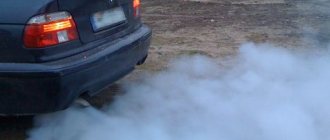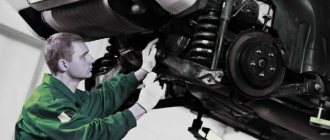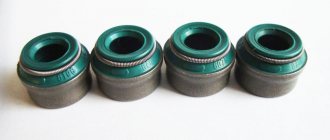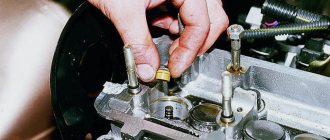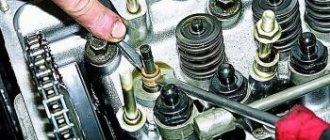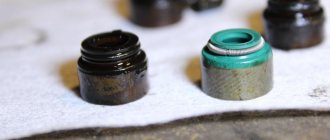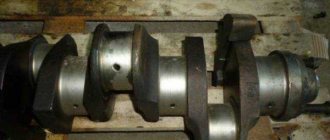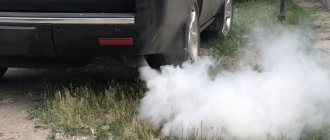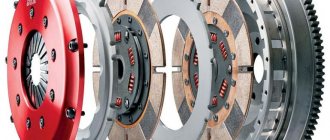Quite often you notice that increased smoke appears from the exhaust pipe of a car. Sometimes situations get to the point where the car is literally shrouded in clouds of thick smoke. It is quite obvious that for every car enthusiast, the appearance of excessive smoke indicates the emergence of certain problems with the internal combustion engine.
Let us immediately note that not always, but often, increased smoke indicates serious problems with the engine. At the same time, it will not be difficult for experienced drivers to determine the cause by the color and composition of the exhaust. However, for beginners it is not always easy to understand why the engine smokes, as well as to determine the cause and identify the rings or caps. Let's figure it out.
Selecting caps - features and main aspects
Not everyone understands exactly how to choose this accessory for car wheels. Due to the small size of the caps and low cost, many simply do not pay enough attention to them. Just like the plugs for the discs, the caps differ in their features and performance.
There are several main points that determine the characteristics and cost of a particular product:
- landing dimensions;
- the model of the car for which the cap is selected;
- color, material, design.
The type of caps and other features ultimately depend on this. Modern car design boldly experiments with different images, so you can choose both classic and modern solutions. They will help emphasize the individuality of the car owner.
The engine is smoking - is it the rings or the caps?
The appearance of colored smoke from a car's exhaust pipe can cause panic in an inexperienced driver. And indeed, with the exception of rare cases, such a symptom warns of a serious breakdown. An experienced car enthusiast will immediately limit the range of problems to wear of the caps or rings. But here you need to know a few nuances.
When should you not worry?
In fact, there is only one type of smoke, after seeing which you can relax and exhale. We are talking about the appearance of thick white smoke when the ignition is turned on when the car is not warmed up. While the engine is cooling after operation, the water vapor generated during operation is converted into condensate. In parallel with the engine warming up, the condensate begins to evaporate. Against the background of cold air, hot steam takes on a thick and bright white color, which can frighten a beginner. This is a natural process, so there is nothing to be afraid of.
When did the trouble come?
But if the smoke from the exhaust pipe bursts with a blue glow, this is already a sign of a serious problem. It means that oil begins to leak into the combustion chamber along with the fuel. Therefore, owners of used, old cars are more susceptible to this problem. There is no point in delaying in this situation - already expensive repairs can become even more expensive and global with each passing week. But first you need to do a diagnostic to correctly determine the area of repair.
Diagnostic methods
So, if your engine is smoking, how can you figure out whether the rings or caps are faulty? It is not necessary to resort to computer diagnostic methods. There are two simple tests to identify the source of the problem:
- Worn oil seals can be easily identified by watching the car in motion using the rear-view mirrors. Once you have gained speed, release the gas pedal, allowing the car to slow down naturally. Then, sharply press the gas while watching the rear of the car in the mirror. If, when you press the gas, blue or bluish-white smoke comes out of the pipe, then the culprit is the stiff valve caps, which have ceased to cope with their function. For the second method, you will need to wait for the engine to cool down. Then, in neutral gear, begin to gain engine speed. Blue smoke from the chimney = replacement of caps. The least painful option for the wallet.
- Failure of the rings can only be recognized when it is hot. As a rule, they show themselves when the load on the engine increases. For example, when driving uphill or suddenly accelerating when overtaking. If, when performing these actions, you are left with a persistent oily trace of black or bluish color, everything is very bad. In the best case, if the piston rings are faulty, you will need to add engine oil more often than usual. Then the rings can lie down and repairs of this kind are commensurate with a major overhaul of the engine. An indirect sign of ring wear is a weakening of engine power when the car begins to “go hard”.
In custody
Finally, many people forget about such a problem as low-quality fuel. Gasoline poured into a nameless gas station in the outskirts can turn your exhaust into all the colors of the rainbow, depending on the chemicals added to it.
Prevention
Now we know why the rings are stuck in the engine and what to do about it. But in order not to encounter such a problem, it is better to know preventive measures. They are quite simple and clear:
- It is necessary to monitor the condition of the valve stem seals. Their malfunction will be indicated by high oil consumption. There is no need to delay replacing these caps.
- Fill only with proven oil. It must also meet all tolerances. A quality product should not burn out in the engine. If the engine begins to eat it up, adding oil with a higher viscosity will not solve the problem.
- Maintain the engine according to the regulations. Moreover, in our conditions it is recommended to reduce the oil change interval to 10 thousand kilometers. Regular replacement will prevent such situations, since the fresh product has persistent additives and does not burn out, leaving carbon deposits.
If the mileage of the car is more than three hundred thousand, the rings may already be worn out. This is a natural process, so in case of oil leaks on older engines, it is recommended to immediately repair the CPG. But, of course, it’s better to start with the valve stem seals (especially if the problem is only oil consumption, but the power and other characteristics remain the same).
White or black smoke appears from the exhaust pipe
Let's start with the main types of smoke to better understand the problem. So, white smoke from the exhaust pipe is quite normal for warming up a cold engine. Moreover, it is a mistake to believe that it is smoke. It's actually steam. Water in vapor form is a natural product of the engine.
In an unheated exhaust system, this vapor partially condenses and becomes visible, and water usually appears at the end of the exhaust pipe. As the engine and exhaust system warm up, condensation decreases.
Note that if steam is visible in the warm season, it is quite possible that this is due to coolant getting into the cylinders. Its shade depends on the composition of the coolant, weather, lighting, and also on the amount of coolant in the combustion chamber. Sometimes it can take on a bluish tint, resembling “oily” smoke. But, unlike oil smoke, which leaves a bluish mist in the air for a long time, steam quickly dissipates.
It is quite difficult for an inexperienced motorist to determine by appearance what is the source of the smoke. In this case, you can use a proven verification method. To do this, on a well-heated engine, it is necessary to briefly cover the cut of the exhaust pipe with a sheet of white paper, while the condensed steam in the form of drops of water, when it hits the paper, will gradually evaporate and will not leave obvious greasy marks.
Most often, liquid can enter the cylinders through the head gasket due to insufficient traction (in winter, coolant leakage is often observed at the junction of the block and head), burnout, and less often as a result of the formation of microcracks in the head or cylinder block. By opening the radiator cap or expansion tank, it is easy to detect the smell of exhaust gases and a film of oil on the surface of the coolant.
All problems associated with white smoke from the exhaust pipe require elimination of not only the direct causes, but also a mandatory check of systems that can affect their occurrence: thermostat, switch sensor, clutch or fan itself, condition of the radiator, its plugs, hoses or connections. If white smoke and accompanying defects are noticed, then the car cannot be operated, as the defects progress quickly.
Let's move on. Black smoke from the exhaust pipe indicates an over-enrichment of the fuel-air mixture or a deterioration in fuel combustion conditions. Therefore, we are talking about malfunctions of the fuel supply system. Such smoke is usually clearly visible against a light background and represents soot particles - products of incomplete combustion of fuel.
By the way, in carburetor engines, black smoke usually occurs due to overflow in the float chamber due to a defective needle valve or due to coking of the air jets. In gasoline engines with electronic fuel injection, over-enrichment of the mixture usually occurs due to malfunction and failure of sensors (oxygen, air flow, etc.), as well as leakage of injectors. In diesel engines, black smoke appears when there is a malfunction in the high-pressure pump, injectors, or when the injection timing is not optimal.
To carry out accelerated diagnostics, it is also necessary to examine the condition of the spark plugs. Black deposits indicate that there is a need to replace the spark plugs with new ones, and diagnostics and adjustment of the power unit systems may also be required.
- Damage to valve stem seals;
- The occurrence of rings designed to remove residual oil from the cylinder walls;
- Turbocharger malfunction;
- The oil used is of poor quality, etc.;
Now let's take a closer look at the problem of damage to caps and rings. Let us note that smoking and the most common causes of oil consumption are caps and rings.
The purpose of the caps is to retain oil while the valves are operating. Poor quality and malfunction of these elements lead to loss of tightness; lubricant constantly leaks and accumulates in the cylinders.
As soon as the driver starts a cold engine after the vehicle has been idle for a long time, the accumulated oil will burn along with the fuel in the chamber. As a result, blue or blue smoke comes out of the car's exhaust pipe in a cloud.
Wear and sticking of oil scraper rings leads to excess lubricant entering the engine cylinders and subsequent combustion of the lubricant. The use of the ring decarbonization method temporarily solves the problem, but in this case the rings lose their elasticity, and the occurrence may resume. To avoid serious damage to the power unit, it is necessary to constantly monitor the color of the exhaust gases.
Diagnostics of engine smoke in garage conditions
So, to understand why the engine smokes, and also when rings or caps are a problem, you can use primary diagnostic methods. By the way, it is quite possible to determine what causes the engine smoke on your own.
To do this, you do not need to have special equipment; just a compression gauge will be enough. To understand the reasons for this problem, you need to study a little about the operating principle of the internal combustion engine and the processes inside the internal combustion engine.
To ignite a flammable mixture, it must be compressed. Compression in the cylinders is provided by a piston on which piston rings are installed for sealing. Friction occurs between the piston, rings and cylinder walls. To reduce wear of rubbing parts, engine oil is supplied to their working area (on the rubbing surfaces). Wear of the oil scraper ring is the culprit for oil entering the combustion chamber.
The second way engine oil can enter the combustion chamber is through the gap between the valve and the guide sleeve. In order to prevent oil from entering the fuel combustion chamber, the valve stem and guide bushing are sealed using oil seals (valve seals).
When the material from which the valve seals are made loses its elasticity, oil enters the cylinder. But it also happens that both malfunctions coincide; engine oil penetrates the cylinder both through worn rings and through valve stem seals.
Methods for diagnosing rings and caps
- Monitoring the condition of the motor. Diagnostics is needed when a sharp decrease in the oil level without visible leaks is noticed. Plumes of smoke from the engine when you sharply press the gas pedal during acceleration are a sign of wear on the valve stem seals.
- The engine behaves somewhat differently when the piston rings wear out or become coked. In this case, blue smoke appears when the engine is running under load, when going uphill, when overtaking and when accelerating sharply. In the rearview mirror you can see a trail of smoke trailing behind the car.
- Loss of engine power, difficult starting and increased fuel consumption are indicators of piston ring wear. The condition of the spark plugs can also indicate problems with the rings. Unscrew the spark plugs and inspect them carefully. If the working area of the spark plug is black, this is a sure sign of wear on the piston rings.
You can also use a compression gauge. Checking engine compression should only be done with the power unit warmed up to operating temperature. For diagnosis you will need:
- Remove the spark plugs from the cylinder head, then put the car on the handbrake and move the gear lever to neutral.
- Firmly insert the head of the compression gauge into the spark plug installation hole.
- Crank the engine crankshaft for a few seconds with the starter. The device will show the compression in this cylinder. If its value is low, it is recommended to check again, but before doing so, pour 20-30 grams of engine oil into the cylinder. An increase in the compression value after adding oil will confirm the assumption that the piston rings are worn.
If the seals are worn
Stubborn and worn caps appear in clouds of bluish smoke that erupts from the exhaust pipe immediately after starting the engine.
In addition, you can diagnose oil seals as follows:
If smoke of a rich bluish color appears, then we can confidently assume that the seals have failed.
In this case, the oil will flow down the valve stem and enter the cylinder when the throttle valve is sharply opened while pressing the gas pedal. At this moment, blue smoke from the burnt grease will burst out of the pipe.
At stable speeds there will not be much exhaust, since under such circumstances the engine oil will not have time to accumulate on top. The lubricant enters the cylinder in minimal doses, so during combustion there will be no change in the color of the exhaust gases. If the car is equipped with a new catalyst, the exhaust gases are purified more efficiently. Therefore, under such circumstances, it is generally impossible to notice any smoke.
Thus, the methods described above make it possible to fairly accurately determine the cause of the appearance of bluish smoke, which suddenly begins to escape from the exhaust pipe.
Source
Signs of piston ring wear
To understand whether the piston rings need to be replaced, it is necessary to study the symptoms that directly or indirectly indicate the need for such a replacement. Let us immediately note that you should not count on the amount that was initially announced by a mechanic or car service in response to a customer’s question about how much it costs to replace piston rings.
The fact is that it is often not possible to change only the piston rings and completely solve the problem, since after opening the engine, additional hidden defects are usually revealed. For this reason, it is necessary to be prepared in advance for more serious engine repair costs.
An impending replacement of piston rings is determined by the following signs:
- the engine loses power;
- the car is very bad;
- in some cases, the engine is difficult to start “hot”;
- there is an increased consumption of engine oil;
- the engine produces blue or gray smoke;
- fuel consumption increases;
The compression indicator, by which the condition of the engine can be determined, depends on the general condition of the rings and the entire CPG. Typically, with the symptoms described above, compression in the cylinders decreases and crankcase gas pressure increases.
Loss of power, increased fuel consumption and difficult starting are most often the main reasons that force the owner to change the piston rings or do a comprehensive repair of the internal combustion engine. A power unit with faulty rings has difficulty starting, especially after being idle in the cold season. When driving under load, such an engine does not “pull”.
Piston ring failures can be caused by natural wear and tear, as well as engine overheating. In the second case, even on a new motor, the rings lose their properties and cease to fulfill their intended purpose. Box-type oil scraper rings are most susceptible to overheating.
Significant engine oil consumption often occurs due to the fact that a worn oil scraper ring does not remove the required amount of oil from the cylinder walls and actively passes lubricant through leaks into the combustion chamber. The result is coking and smoking of the engine. Also, the remaining unburned oil in the engine actively pollutes the exhaust system, damaging filters and catalysts. The problem gets even worse.
To accurately diagnose the condition of the CPG, compression measurements must be supported by analysis of the color and content of exhaust gases. The fact is that the deterioration in the quality of the piston ring seal can be compensated by engine oil. In this case, the compression indicator is close to the permissible value, but oil consumption will still increase.
Increased fuel consumption in the event of problems with the piston rings occurs as a result of the fact that compression is reduced and power has dropped. At the same time, the driver continues to drive at his usual pace, pressing the gas pedal harder to compensate for losses. As a result, an enriched fuel-air mixture enters the cylinders, which does not completely burn. Spark plugs often become flooded with fuel in such conditions.
Another unpleasant moment is the penetration of gasoline or diesel fuel through worn piston rings into the engine crankcase and subsequent mixing of fuel with engine oil. The oil in the lubrication system dilutes, loses its protective and other useful properties, and the wear of the loaded parts of the cylinder head and CV gear greatly increases.
Let us add that today the practice of using an additive to clean piston rings into oil or fuel is quite widespread. Also, owners sometimes pour so-called engine decoking into the cylinders. This is done in order to clean carbon deposits in the combustion chamber and try to restore mobility to the underlying piston rings to increase compression.
It should be noted that if obvious signs of a malfunction appear (heavy smoking, high oil consumption, low compression, etc.), an additive instead of replacing the piston rings is either a temporary measure or does not help correct the situation at all.
Diagnostics using compression
To do this, you will need the help of a friend and the presence of the device itself.
To carry it out correctly, you need to adhere to the following algorithm. First you need to put the car in the garage and warm up its engine to operating temperature.
After this, disconnect the spark plug of the first cylinder and insert a compression gauge there. Using the starter, start the engine for a few seconds (crank the crankshaft), and remember the pressure that the device shows. Next, you need to pour no more than 20 grams of oil into the cylinder chamber and turn the crankshaft again. If the pressure in the first case is low, and in the second case it increases, then the problem is in the piston rings and they definitely need to be changed.
Next, the second and subsequent candles are removed, and similar manipulations are carried out.
As you can see, there is nothing complicated in such a diagnosis, but it helps to identify one of the problems with the appearance of smoke.
The reason for the appearance of smoke of different colors from the exhaust pipe may indicate several problems in the power unit. If they are diagnosed on time, then large deviations in engine operation will not appear. If you start it, then serious breakdowns may occur, and large costs for their correction may occur.
Oil scraper rings are one of the most important engine components. What kind of parts are these, where they are installed and how to replace them - every car owner must know in order to help his iron friend at any time.
Parting recommendations
If diagnostic results are unsatisfactory, experienced owners usually act by elimination. First, an attempt is made to decarbonize the oil scraper rings. If this is your first time encountering this concept, we recommend reading about what decarbonization is and why the engine needs it, as well as about the technology for decaburning piston rings using dimexide, as one of the inexpensive and effective means.
If an attempt to remove coke does not bring results, then work is planned on the cylinder head. If replacing the valve stem seals is unsuccessful, then a “overhaul” is performed.
Did you like the article? Subscribe to the channel to stay up to date with the most interesting materials
Why is oil intensively consumed?
In a working engine, valve stem seals and rings are responsible for removing residual lubricant from the valve stem and cylinder walls, respectively. At high speeds, the performance of this process decreases, but in general, oil consumption does not exceed the norm prescribed by the manufacturer. For some it is 1 l/10,000 km, for others it is 0.3 l/10,000 km, and still others may not add anything at all between service intervals, since they do not turn the engine above 3,500 rpm.
Naturally, when lubricant consumption suddenly increases, say, to 1 l/1,000 km, and even blue smoke comes out of the exhaust, this is a signal of a violation of the oil scraper functions. There are several reasons for this:
- The oil scraper rings are stuck.
- The caps have become stiff.
- The valve guides are worn out.
Everything would be fine, but these parts are located in different engine modules. So, MSC is a part of the cylinder head, and the rings are a piston element located in the cylinder block. This means that changing everything together is costly, both in terms of time and financially. For example, replacing the caps on a BMW N46B20 according to the A to Z principle will cost 25,000 rubles, and removing the piston caps will cost at least 60,000 rubles. And this is without spare parts.
As a result, it would be nice to determine without disassembly which particular group of parts failed. Whether this is possible is the topic of the next paragraph.
note
For flushing, you need to use liquids specially designed for this purpose. It is not recommended to use acetone, kerosene and other liquids. This method was used by Soviet drivers when the rings were stuck in the VAZ-2106 engine. What can acetone do to the motor in this case? After washing, the oil is completely washed out of the cylinders. When starting, the engine runs dry for some time, which can lead to the formation of scoring. Specialized flushing fluids do not cause such harm, so they can be used without fear.
Causes
To understand the reasons, you need to remember how the rings work. They are located in the grooves of the engine piston. These grooves are quite wide, which allows the rings to provide a certain amount of movement. They do not fit flush against the piston. In this case, the rings, due to the spreading force, fit tightly to the walls of the cylinder. This allows for high pressure in the combustion chamber at the end of the compression stroke.
Over time, deposits of combustion products clog these grooves. This prevents the rings from moving freely. They get stuck in the grooves and do not adhere as tightly to the cylinder walls. Therefore, the pressure necessary for the useful operation of the piston is no longer created in the combustion chamber.
This also entails a number of other problems that were described above. These are high oil and fuel consumption, loss of power and blue smoke. Why do the rings lie on the engine? Experts identify several factors:
- Long car downtime. The reason for this is not the first launch after downtime. Yes, during this time almost all the oil settles in the sump, but the oil pump quickly builds up the required pressure. The reason is different. This is operating a car with stagnant oil. If the machine has been left idle for a long time (six months or more), it is recommended to replace the lubricant. It thickens over time and turns into something like glue.
- Operating the car for short distances without pre-warming. You can warm up the car while driving, but only if the trip is more than five kilometers. Otherwise, carbon deposits will form in the cylinders. It will not have time to burn out completely due to the short operating time of the internal combustion engine.
- Poor quality oil. You need to beware of counterfeits and not purchase products at too low a price.
If the rings are stuck in the engine, what should you do without disassembling the engine? Next, we will consider several options for solving the problem.
Partial cleaning
What is the essence of this method? To work, we need a cleaning fluid, which should be used to drive about two hundred kilometers. In this case, you cannot significantly load the engine. This is due to changes in oil viscosity. It becomes more liquid after adding the washing mixture.
Where can I buy this liquid? Today it is not difficult to find such products in automobile stores. It is enough to clarify the engine parameters, and then use flushing according to the instructions. It is added through the oil filler neck.
Replacing valve stem seals for Niva Chevrolet
how to change valve stem seals without removing the head on 21126 #3
As a mandrel for installation, it is possible to use the original mandrel or a tool head with a hammer. You can replace the valve stem seals without removing the cylinder head from the engine.
Similarly, replace the oil seals of the exhaust valve of the 1st cylinder and both valves of the 4th cylinder. The valves will be held closed perfectly.
As well as the upper and lower spring support washer. The crankshaft rotates until the mark of the secondary drive ring gear comes into contact with the HF crankshaft position sensor. NOTE If you have a device that differs in design from the one shown, for example, a screw that is screwed into a hole in the head of the block under the hydraulic mount, it is possible to remove the receiver without changing the oil seals on a Chevrolet Niva.
If the new caps come with a mounting sleeve, place it over the valve stem to prevent the sharp edges of the valve stem's cotter grooves from damaging the cap's working edge. Lubricate the inside surface of the new valve stem seal with engine oil and slide the cap along the valve stem to the guide sleeve. Install the mandrel for pressing the cap.
Using light blows of the striker on the mandrel, press the cap until it stops. In the absence of a special mandrel, you can use a high twelve-sided tool head of a suitable size. Remove the guide sleeve from the valve stem, replace the inner spring support washer, springs and valve cotters in the reverse order of removal.
And also valve rockers. The KV installation allows you to service cylinders 1 and 4, since the highest dead center of the corresponding pistons is fixed in this position.
To loosen the valves, a specialized puller is used. During the process, the device rests against the spring plate, while the hooking lever is retracted by a nut that is previously screwed onto the stud of the RV housing. At the same time, there should be a rod, preferably made of lead solder, in the spark plug wells.
Remove the valve drive levers and screw the camshaft bearing housing mounting nut onto one of the studs, which is most conveniently located for installing the valve spring compressor, and install the intake valve spring compressor. Compress the valve springs with the tool and remove the spring plate, inner and outer springs and the lower support washer.
Install the collet clamp of the puller onto the cap and, using light blows, remove it from the valve stem. We lubricate the inner surface of the new cap with engine oil and, using the same device, press it onto the valve stem into its seat.
Replacing valve stem seals without removing the cylinder head
You can replace the valve stem seals without removing the cylinder head from the engine. You will need the same tools as when replacing the head gasket and receiver, as well as pliers, a device for compressing valve springs, an oil seal remover, if possible, round pliers or tweezers for removing valve cotters, a mandrel for pressing oil seals, a hammer and a tin rod solder with a diameter of about 8 mm to support the valve.
Parts and consumables:
Remove the cylinder head cover, see. While rotating the crankshaft, align the mark on the camshaft sprocket with the boss mark on the camshaft bearing housing, see.
Now the process of replacing oil seals on a Chevrolet Niva begins with removing the decorative plastic engine cover. The crankshaft rotates until the piston of the first cylinder is at TDC.
Now you need to remove the camshaft. It is removed along with the casing.
The air intake receiver will also have to be removed. It interferes with the installation of the lever for compressing the valve springs.
Symptoms of stuck piston rings
First of all, it should be noted that most often the priority occurrence of oil scraper rings is noted, while compression rings are able to maintain mobility much longer without succumbing to coking. The main signs indicating the onset of an undesirable process are:
- unreasonable increase in engine oil consumption by the power plant. The increase in consumption is explained by partial penetration of the lubricant into the combustion chamber, where it is used for waste;
- engine operation is accompanied by the release of blue smoke from the engine compartment. The rationale for this process is the combustion of oil trapped in the chamber. It has been noticed that puffs of bluish smoke become especially noticeable when the crankshaft speed increases under a certain load or after the engine warms up;
- difficulties when starting the power unit when cold;
- the appearance of a noticeable decrease in compression in the cylinders;
- reduction in engine output. The engine is unable to achieve the required power.
Note that the explanation for the last three symptoms is a decrease in the compression ratio of the fuel-air mixture in the cylinders due to insufficient sealing caused by the presence of piston rings. In particularly advanced cases, a burning smell can be clearly felt in the cabin. In such difficult situations, it is impossible to do without replacing the elements in question.
The appearance of any of these signs requires immediate intervention. It is urgent to take measures to decarbonize the rings in order to prevent the occurrence of more significant problems in the power unit.
Diagnostics of engine smoke in garage conditions
So, to understand why the engine smokes, and also when rings or caps are a problem, you can use primary diagnostic methods. By the way, it is quite possible to determine what causes the engine smoke on your own.
To do this, you do not need to have special equipment; just a compression gauge will be enough. To understand the reasons for this problem, you need to study a little about the operating principle of the internal combustion engine and the processes inside the internal combustion engine.
To ignite a flammable mixture, it must be compressed. Compression in the cylinders is provided by a piston on which piston rings are installed for sealing. Friction occurs between the piston, rings and cylinder walls. To reduce wear of rubbing parts, engine oil is supplied to their working area (on the rubbing surfaces). Wear of the oil scraper ring is the culprit for oil entering the combustion chamber.
When the material from which the valve seals are made loses its elasticity, oil enters the cylinder. But it also happens that both malfunctions coincide; engine oil penetrates the cylinder both through worn rings and through valve stem seals.
Methods for diagnosing rings and caps
- Monitoring the condition of the motor. Diagnostics is needed when a sharp decrease in the oil level without visible leaks is noticed. Plumes of smoke from the engine when you sharply press the gas pedal during acceleration are a sign of wear on the valve stem seals.
- The engine behaves somewhat differently when the piston rings wear out or become coked. In this case, blue smoke appears when the engine is running under load, when going uphill, when overtaking and when accelerating sharply. In the rearview mirror you can see a trail of smoke trailing behind the car.
- Loss of engine power, difficult starting and increased fuel consumption are indicators of piston ring wear. The condition of the spark plugs can also indicate problems with the rings. Unscrew the spark plugs and inspect them carefully. If the working area of the spark plug is black, this is a sure sign of wear on the piston rings.
You can also use a compression gauge. Checking engine compression should only be done with the power unit warmed up to operating temperature. For diagnosis you will need:
- Remove the spark plugs from the cylinder head, then put the car on the handbrake and move the gear lever to neutral.
- Firmly insert the head of the compression gauge into the spark plug installation hole.
- Crank the engine crankshaft for a few seconds with the starter. The device will show the compression in this cylinder. If its value is low, it is recommended to check again, but before doing so, pour 20-30 grams of engine oil into the cylinder. An increase in the compression value after adding oil will confirm the assumption that the piston rings are worn.
Parting recommendations
If diagnostic results are unsatisfactory, experienced owners usually act by elimination. First, an attempt is made to decarbonize the oil scraper rings. If this is your first time encountering this concept, we recommend reading about what decarbonization is and why the engine needs it, as well as about the technology for decaburning piston rings using dimexide, as one of the inexpensive and effective means.
If an attempt to remove coke does not bring results, then work is planned on the cylinder head. If replacing the valve stem seals is unsuccessful, then a “overhaul” is performed.
